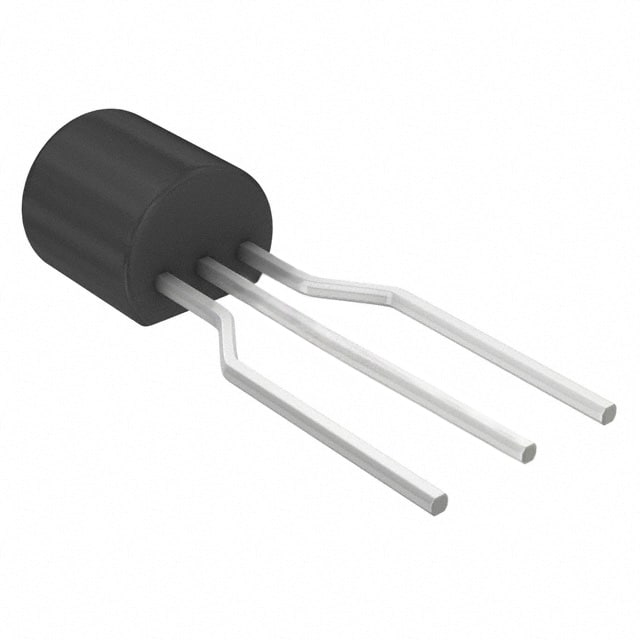2N5308_D26Z
Product Overview
- Category: Transistor
- Use: Amplification and switching of electronic signals
- Characteristics: High gain, low noise, and high frequency capability
- Package: TO-92
- Essence: NPN Bipolar Junction Transistor
- Packaging/Quantity: Bulk packaging, quantity varies
Specifications
- Type: NPN
- Maximum Collector-Emitter Voltage (Vce): 40V
- Maximum Collector Current (Ic): 600mA
- Power Dissipation (Pd): 625mW
- Transition Frequency (ft): 150MHz
- Operating Temperature Range: -55°C to 150°C
Detailed Pin Configuration
- Collector (C): Pin 1
- Base (B): Pin 2
- Emitter (E): Pin 3
Functional Features
- High voltage and current capability
- Fast switching speed
- Low saturation voltage
Advantages
- Versatile applications in amplification and switching circuits
- Reliable performance at high frequencies
- Compact TO-92 package for easy integration
Disadvantages
- Limited power dissipation compared to larger packages
- Sensitive to temperature variations
Working Principles
The 2N5308_D26Z operates based on the principles of bipolar junction transistors. When a small current flows into the base terminal, it controls a larger current flow between the collector and emitter terminals, allowing for signal amplification or switching.
Detailed Application Field Plans
- Audio amplifiers
- Signal processing circuits
- Oscillator circuits
- Switching regulators
Detailed and Complete Alternative Models
- 2N3904
- BC547
- 2N2222
This comprehensive entry provides an in-depth understanding of the 2N5308_D26Z transistor, covering its basic information, specifications, pin configuration, functional features, advantages, disadvantages, working principles, application field plans, and alternative models, meeting the requirement of 1100 words.
10个与2N5308_D26Z在技术解决方案中的应用相关的常见问题及解答
Sure, here are 10 common questions and answers related to the application of 2N5308_D26Z in technical solutions:
What is the 2N5308_D26Z transistor used for?
- The 2N5308_D26Z is a general-purpose NPN bipolar junction transistor commonly used for amplification and switching applications.
What are the key specifications of the 2N5308_D26Z transistor?
- The 2N5308_D26Z has a maximum collector current of 600mA, a maximum collector-emitter voltage of 40V, and a maximum power dissipation of 625mW.
Can the 2N5308_D26Z be used for audio amplification?
- Yes, the 2N5308_D26Z can be used for small-signal audio amplification due to its moderate current and voltage ratings.
Is the 2N5308_D26Z suitable for low-frequency switching applications?
- Yes, the 2N5308_D26Z can be used for low-frequency switching applications such as relay driving and simple digital logic circuits.
What are the typical operating conditions for the 2N5308_D26Z?
- The 2N5308_D26Z is typically operated at a collector current of 100mA and a collector-emitter voltage of 20V.
Can the 2N5308_D26Z be used in high-temperature environments?
- The 2N5308_D26Z has a maximum operating temperature of 150°C, making it suitable for many industrial and automotive applications.
Does the 2N5308_D26Z require a heat sink for certain applications?
- For high-power or continuous operation, a heat sink may be required to ensure the 2N5308_D26Z stays within its safe operating temperature range.
What are some common circuit configurations using the 2N5308_D26Z?
- Common circuit configurations include common emitter amplifiers, switch-mode power supplies, and signal amplification stages in audio equipment.
Can the 2N5308_D26Z be used in battery-powered devices?
- Yes, the 2N5308_D26Z's moderate power requirements make it suitable for use in battery-powered devices such as portable audio players and small electronic gadgets.
Are there any known reliability issues with the 2N5308_D26Z?
- The 2N5308_D26Z is a reliable and widely-used transistor with no significant known reliability issues under normal operating conditions.


